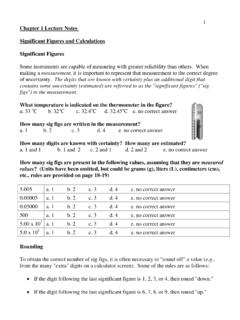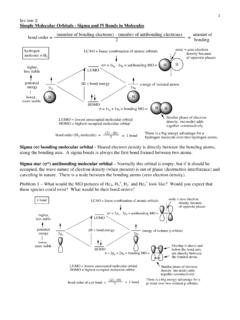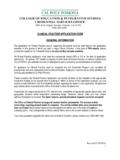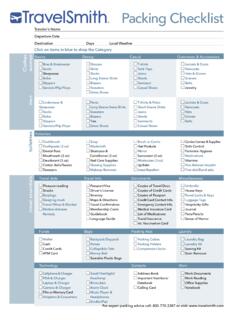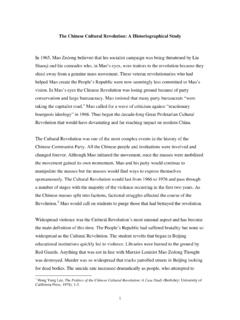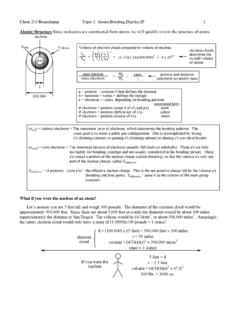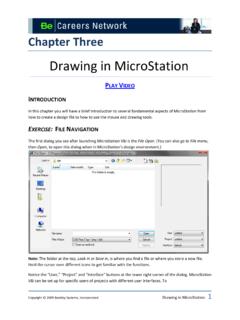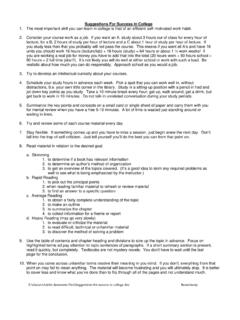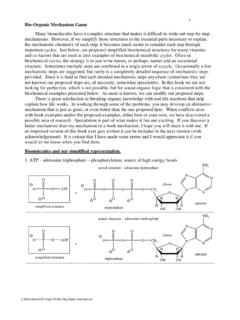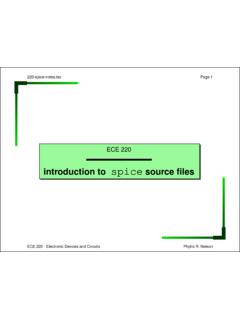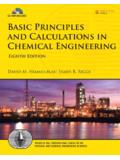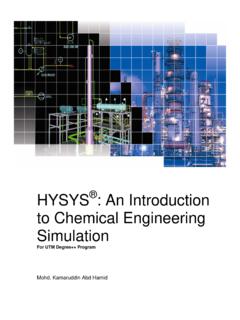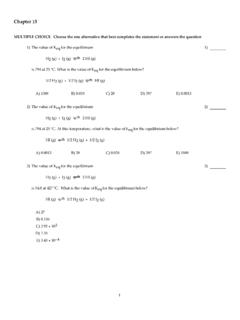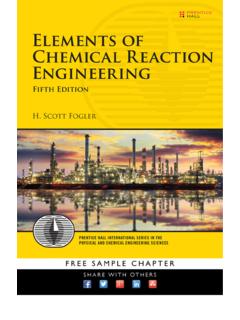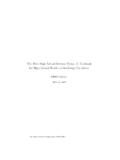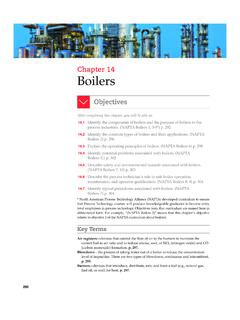Transcription of Chemical Engineering Thermodynamics II - CPP
1 Chemical Engineering Thermodynamics II (CHE 303 Course Notes) Nguyen Chemical and Materials Engineering Cal Poly Pomona (Winter 2009) Contents chapter 1: Introduction Basic Definitions 1-1 Property 1-2 Units 1-3
2 Pressure 1-4 Temperature 1-6 Energy Balance 1-7 Example : Gas in a piston-cylinder system 1-8 Example : Heat Transfer through a tube 1-10 chapter 2: Thermodynamic Property Relationships Type of Thermodynamic Properties 2-1 Example : Electrolysis of water 2-3 Example : Voltage of a hydrogen fuel cell 2-4 Fundamental Property Relations 2-5 Example.
3 Finding the saturation pressure 2-8 Equations of State 2-11 The Virial Equation of State 2-11 Example : Estimate the tank pressure 2-12 The Van de Walls Equation of State 2-13 Example : Expansion work with Van de Walls EOS 2-15 Soave-Redlick-Kwong (SRK) Equation 2-17 Example : Gas Pressure with SRK equation 2-17 Example : Volume calculation with SRK equation 2-18 Properties Evaluations 2-21 Example : Exhaust temperature of a turbine 2-21 Example : Change in temperature with respect to pressure 2-24 Example : Estimation of thermodynamic property 2-26 Example : Heat required to heat a gas 2-27 chapter 3.
4 Phase Equilibria Phase and Pure Substance 3-1 Phase Behavior 3-4 Example : Specific volume from data 3-7 Introduction to Phase equilibrium 3-11 Pure Species Phase equilibrium 3-12 Gibbs Free Energy as a Criterion for Chemical equilibrium 3-12 The Chemical Potential 3-13 Vapor Liquid Phase equilibrium 3-16 Example : Horsepower of a compressor 3-18 Example.
5 Two-level refrigeration system 3-19 The Clapeyron Equation 3-23 Example : Triple point estimation 3-27 Refrigeration 3-30 i Example : A vapor compression refrigeration cycle 3-31 Example : A refrigeration cycle using refrigerant 134a 3-32 Example : A refrigeration cycle using refrigerant 134a 3-34 Example : A refrigeration cycle with nonideal compressor 3-35 Partial Molar Properties 3-36 Example : Partial molar volume 3-37 Example : Enthalpy of mixing 3-38 Example : Enthalpy-concentration chart 3-39 chapter 4: Principle of Phase equilibrium II The Phase Rule 4-1 Example : The degree of freedom 4-1 Example.
6 Degree of freedom for vapor-liquid equilibrium 4-2 The Fugacity 4-3 Example : Fugacity of liquid water 4-5 Example : Fugacity using Van der Waals EOS 4-6 Example : Fugacity of steam 4-10 Example : Change in Gibbs energy 4-11 Fugacity of Species i in a Gas Mixture 4-15 Example : Fugacity using Peng-Robinson EOS 4-17 Fugacity in the Liquid Phase 4-19:20 chapter 5: Applied Phase equilibrium Vapor-Liquid equilibrium for Ideal Systems 5-1 Example : Bubble point temperature calculation 5-3 Example : Bubble point pressure calculation 5-5 Example : Dew point temperature calculation 5-6 Example : Dew point pressure calculation 5-8 Example : Txy diagram for benzene-toluene mixture 5-9 Example.
7 Dew point pressure using K-values 5-11 Isothermal Flash Calculation Using K-values 5-15 Example : Isothermal flash with V/F specified 5-18 Example : Isothermal flash with T specified 5-20 Vapor-Liquid equilibrium with Non-ideal Liquid 5-23 Example : Bubble point pressure with Van Laar model 5-25 Example : Bubble point temperature with Wilson model 5-26 Example : Dew point temperature with Wilson model 5-28 Example : Txy diagram with Wilson model 5-31 Fitting Activity Coefficient Models with VLE Data 5-35 Example : Evaluation of Margules and Van Laar parameters 5-37 Example : Evaluation of Wilson parameters 5-43 Azeotropes 5-45 Example.
8 Evaluation of Wilson parameters 5-50 Estimation of Activity Coefficients 5-52 Example : Acetone mole fraction in a system with air 5-52 Example : Solubility of ethane in n-heptanol 5-54 Phase Behavior in Partially Miscible Systems 5-55 ii Example : Liquid mixture in two separate phases 5-56 Example : Liquid mixture in a single phase 5-56 Example : LLE for a binary mixture 5-61 Vapor-Liquid-Liquid equilibrium : VLLE 5-63 Example : Composition and pressure for a VLLE system 5-64 Example : VLLE calculations 5-66 Example : VLLE estimation 5-68 Example : VLLE for water and hydrocarbon 5-71 The Thermodynamics of Osmosis 5-73 Example : Estimation of the PVC molecular weight 5-76 Example : Dissociation of NaCl molecules 5-78 Distribution of a Solute Between Liquid Phases 5-79 Solubility of a Solid in a Liquid Phase 5-79 Example : Solubility of a Drug 5-81 Distribution of a Solute Between Liquid Phases 5-84 Example : Drug Extraction from the Aqueous Phase 5-87 Example.
9 Purification of an Antibiotic 5-88 Single-Stage equilibrium Extraction 5-89 Example : Drug Extraction from the Aqueous Stream 5-90:91 chapter 6: Chemical equilibrium Introduction 6-1 Example : Extent of reaction and fractional conversion 6-2 Example : Time to reach 90% conversion in a batch reactor 6-5 Chemical Reaction and Gibbs Energy 6-6 The Condition of equilibrium for a Chemical Reaction 6-9 Calculation of equilibrium Constant from Data 6-11 Example : equilibrium constant for methanol reaction 6-11 Example : equilibrium constant for nitrogen oxide 6-12 Variation of equilibrium Constant with Temperature 6-14 Example : Methanol reaction at 60oC
